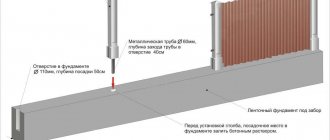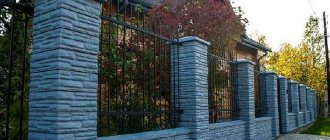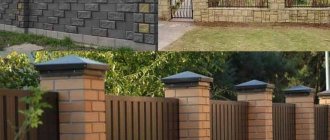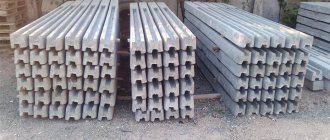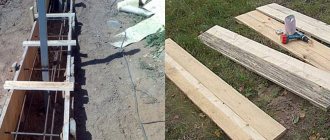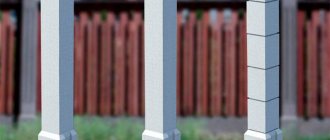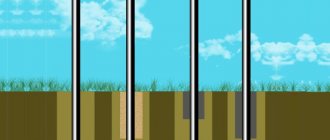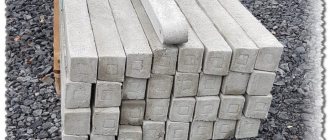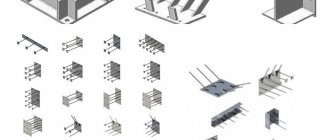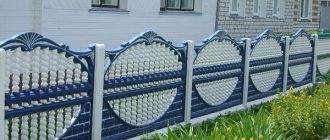Fencing is necessary to protect the site and give it a more attractive appearance. The fence is the first structure, it is visible to passers-by and guests. The work must be done to the highest possible quality. A fence is built to be used for many years, it is important to make it durable. It can be built from any materials; their range today is striking in its diversity. Regardless of which option is chosen, the main thing is to perform the installation correctly, paying special attention to the supporting elements. the durability of the structure depends on them. You can actually do the work yourself. Place the supports, secure the logs, then cover the fence with facing material - the main steps. Developers use facing materials - profiled sheets, wooden picket fences, chain-link, some of the most popular materials today.
Wooden poles
The material is considered a traditional option and has been used for many centuries in a row. Today, using wood is quite expensive, especially for really high quality options. The construction of such options must be done using solid hardwood logs. Practical options that are distinguished by high levels of resistance to negative weather conditions include pine, larch, ash, oak, acacia, and mulberry. practical options are representatives of the spruce or fir group. It is not recommended to build a fence from birch, maple, linden, aspen, or alder. You can actually increase the service life by treating it with special antiseptic preparations. Sometimes the ancient method of charring is used. Modern companies produce a variety of compounds that protect wood, destroy various microorganisms and pests that destroy the material. The action of other compositions significantly reduces the penetration of moisture, which reduces the likelihood of the development of the rotting process. Wood is used extremely rarely for the construction of fences today. More often the elements are used if it is intended to erect a fence using a wooden picket fence. In this way it is possible to create a complete structure.
Work planning
Once you have an understanding of the type of soil and the characteristics of the area, you need to calculate the perimeter of the area you want to fence. The total value of the resulting perimeter will help determine the number of meters and racks required.
Fence panels and posts come in different sizes, so plan your new fence from scratch or measure the size of your existing fence. During the planning stage, it is useful to determine the type of messages that suit your needs. They can be:
- · corner posts (with two struts at an angle of ninety degrees);
· intermediate racks (without struts);
· end posts (with only one reinforcement post);
· reinforcement posts (with two struts).
These nuances are important when it comes to using mesh in rolls. This does not apply to modular panels that are installed without struts. The concept of the ideal distance between posts is very arbitrary. It depends on the desire of the owner, the type of mesh used and the characteristics of the soil. The average value is 2-2.5 m. This gap is used for simple and electric welded mesh. The distance is easier to calculate if you choose a panel fence. With this design, the guideline for the subsequent installation process is the length of the panels.
Metal pole options
A common option today are metal frames. Such fencing elements go well with various facing materials - wooden picket fence, chain-link mesh or profiled sheets. Metal poles can withstand significant loads; they are installed even in regions with strong wind loads. The disadvantage of metal products is due to their susceptibility to corrosion. To prevent this phenomenon, it is worth treating the surface with special anti-corrosion compounds. The diameter of the pillars and the wall thickness depend on the design features. The best option is to use rolled metal with a cross-section of 6 centimeters and a wall thickness of 2 mm. Other parts are attached to the metal support.
Corrosion protection methods
Without protection, metal quickly corrodes and loses strength, spoiling the appearance of fence posts. To prevent such a phenomenon and extend the service life of a metal pipe, its surface is galvanized by hot immersion in a zinc solution. The finished surface does not react with oxygen, water and chemical compounds in the air and soil.
Another way to protect pipes in production is to coat them with polymer films. They are applied in a thin layer to the metal surface. This method of insulation is effective for an almost unlimited amount of time, provided that the layer is intact.
The most reliable pipes have double protection with both zinc and polymers at the same time.
Even the highest quality protective coating is not able to withstand the elements of the earth for a long time and soon the galvanization and polymer layer are damaged, and the oxidation of the metal begins. To eliminate this process, the buried part of the pillar must be additionally isolated from the aggressive environment.
How to treat metal fence posts in the ground:
- Bitumen mastic;
- Special polymer mastic for metal processing.
The choice is small, but these products are highly effective and inexpensive. Coating is carried out at the stage of preparation for the construction of the fence. It is necessary to allow the mastic to dry before deepening the structure. Rolled materials are completely ineffective, so installing them in a drilled hole is pointless.
Pillars as concrete elements
Durability and reliability are the main characteristics of concrete elements. Disadvantages of the products include high cost and difficulty in installation. It is worth mentioning the rather complex fastening of the transverse joists. The use of special anchors and fastening systems will be required. The design is more often used for the construction of powerful fences.
Briefly about the main thing
To install support posts for a fence, 3 methods are used: concreting, backfilling, driving.
Hammering fence posts is an effective method of constructing supports, economical, but labor-intensive.
The advantages include quick installation and use in many types of soil. Disadvantages: fragility (up to 10 years) and labor intensity.
For light decorative or temporary fences up to 1.5 m high, driving is done using a sledgehammer; to speed up the process, use a hammer drill (using a special attachment).
For high posts (up to 3 meters high), it is advisable to drive the posts using a headstock; if you need to mount the fence quickly and do not take into account the financial issue, you can drive the posts using a piledriver.
Brick pillar options
The attractive appearance conceals the complexity of the structure. Without the necessary experience in bricklaying, it is recommended to entrust the work to specialists. The end result is a high-quality result. Before building such structures, you will need to make a foundation, skipping such work; at the beginning of seasonal soil movement, such a brick structure will simply collapse, and after some period the whole fence will deteriorate. If installed correctly, brick elements can last for several decades, maintaining their original qualities. The design is combined with profiled metal or wooden picket fences.
Concreting the supports
Just like when hammering in a fence, calculations and drawing up a diagram are important. Let's look at how this happens in practice.
Method selection and calculations
At the initial stage, it is important to choose exactly how concreting will take place. There are several methods for this:
- If the soil is stable and there is little moisture, then complete concreting occurs.
- When the soil is weak and groundwater is close, partial flooding occurs.
As for the calculations, they are the same as for scoring.
Required materials and tools
Typically, the following materials are used for this type of support installation:
- metal pipes;
- brick;
- concrete;
- stone.
As for tools, a drilling device and a bayonet shovel are suitable.
Installation of metal supports
Installation of such a fence is carried out as follows:
- The site, as last time, is marked along the perimeter.
- The holes are dug out using a shovel or drill.
- Crushed stone is poured onto the bottom to a depth of ten centimeters.
- Metal poles are installed in the holes.
- Concrete is mixed and poured.
- The pipe is fixed until the concrete begins to harden.
Post Views: 385
Installation of wooden poles
To build a fence, it is recommended to use rolled metal with a diameter of 10-15 centimeters. The size depends on what load is applied. Before installation, it is important to dry the elements and then treat them. You can protect wood from rotting by using a solution of vitriol or using modern antiseptic solutions. The lower part, which is located underground, must be tarred and then additionally wrapped in roofing felt.
When it is intended to erect a fence up to 2 meters high, the ground part of the pillar must be at least 1.5 meters. It is recommended to deepen it 50 centimeters. By increasing the ground part, it will be necessary to deepen it more proportionally. It is recommended to use a proportion of 1/3. The third part of the length of the element should be deepened. The formula makes it possible to make the fence as durable as possible.
The hole should be drilled using a drill; it is recommended to form it with more support. When the hole is ready, it is recommended to completely cover the bottom with sand or screenings, forming a cushion. Then you should lower the support. Having installed it vertically, you need to fill it with crushed stone and compact it. The top layer will be the earth. When performing installation, it is important to control the verticality of each part; the final result depends on this.
Hammering with a headstock
If the fence is planned to be of light construction but of significant height (from 1.5 to 3 meters), using a sledgehammer when hammering becomes difficult.
In this case, a special device, popularly called a “grandmother,” will help drive the profile pipe into the ground under the fence. The mechanism of the device is simple; anyone can assemble it using available materials:
The basis of the “headstock” is a meter-long pipe with an internal diameter slightly larger than the transverse size of the support being driven in. It should fit easily onto the pole.
“Granny” with your own handsSource fb.ru
- On one side of the pipe, a circle of metal is welded, as well as, in order to maximize the weight of the structure, additional metal elements. Ideally, the “grandmother” should weigh from 10 to 30 kg. The heavier the device, the easier and faster it is to hammer the stand into the ground.
- When welding a metal circle, it is recommended to place the circle not at the end of the pipe, but with a recess of several centimeters inward. The resulting “glass” is filled with molten lead. This procedure will make the structure as heavy as possible.
- For ease of use of the device, two metal handles measuring up to 1.5 meters in length are welded to the edge of the pipe without weighing it down.
Driving pillars with a "grandmother"Source ytimg.com
The technology for driving pillars with a headstock is simple. The support is installed in the desired location. A “grandmother” is put on the upper part. It's better to score together. Using welded handles, the mechanism is lifted to a height of about half a meter and sharply lowered, while applying some effort. The pipe is lowered along the support and, using lead weights, drives the post into the ground.
Installation of asbestos-cement pillars
It is recommended to purchase material from trusted suppliers. More often today there are products with a diameter of about 12 centimeters. It is quite difficult to call such a support strong; it is better to use asbestos-cement pillars only for the construction of lightweight structures. If installed correctly, the service life can be several decades.
To begin with, it is worth drilling wells. If the height of the pillar is more than two meters, the hole must be made about 80 centimeters. It is important to make the hole at the bottom expanded; the space is subsequently filled with concrete.
It is recommended to place a metal rod inside the asbestos-cement pipe. It is recommended that it be concreted. The fence must be attached to the pipe very carefully, since the material is quite fragile.
Aesthetics of the issue
When choosing a new fence, you probably want its aesthetic to match the overall style of your garden. Instead of treating the design as a boundary, why not make it a standout feature?
You will need to determine the height of the panels and posts required, as well as the length of the panels and their number. Consider the type of fence. This can be not only mesh metal, but also panels such as corrugated sheets, wooden panels, forged products. At this stage, it is worth exploring all possible options so that you do not later regret missed opportunities regarding the design of the fence.
For example, appreciate how stylish the combination of metal and wood looks. How beautiful painted mesh looks if you're on a budget. You might like profiled sheets with a wood-like design or colorful, eye-catching colors.
There are so many traditional and modern fencing options available that there is an option to suit all homeowners—and remember, stylish fencing goes beyond the use of decorative panels. By incorporating a range of fence rails, post caps and gravel boards, you can create a complete garden fence just the way you want it.
Construction of brick pillars
Before you begin the actual construction of the columns, you need to fill the foundation. The best option is a strip base. To equip it, it is recommended to prepare a trench by laying broken bricks and rubble there, and filling it with concrete mortar on top. The base can only be made under the pillar; it is better to make it a little larger than the support itself. It is recommended to make the ground part of the appropriate size, like a column. It is important to pre-concrete the reinforcement; as an option, a profiled pipe is used; it should go from the foundation directly to the pillar.
When the concrete base is ready and completely hardened, it is time to start laying bricks. The base surface should be painted with liquid bitumen or a layer of roofing material should be used. The brick is laid around a metal frame. It is important to control the horizontalness of each row. After the construction of the structure, its internal void is filled with concrete mortar.
To obtain a reliable result, experience in bricklaying is required. Without it, it is recommended to entrust the work to experienced specialists. It is recommended that you first familiarize yourself with their work.
Driving metal posts and wooden supports - the pros and cons of the method
Financial capabilities and time reserves do not always allow you to build a concrete foundation for a fence. In this case, wanting to speed up the process of constructing a fence and reduce costs, site owners often use the method of plunging supports into the soil using a regular sledgehammer or using a special device.
Driving metal posts
When deciding to use the driving method, evaluate all the features of the technology. Main advantages:
- the ability to immerse supports into the ground without performing excavation work. When using the impact method, the installation process is simplified and installation time is reduced;
- a significant reduction in the cost of installing posts for the future fence. A sharp reduction in the estimated cost is influenced by the lack of need to use Portland cement, gravel and sand;
- no need to involve assistants or use special equipment. It’s easy to drive the posts into the ground yourself, using a massive sledgehammer or a hand-held device;
- stability of columnar supports driven into the soil. With a low moisture content in the soil and the location of aquifers at an increased depth, the supports will retain their original position.
The main disadvantages of the impact method:
- a sharp decrease in the stability of the fence with supports driven into peat, sandy and swampy soils. With an increased area of the fence, the supports may become skewed and the fence may fall due to the increased windage;
- significant deformation of the upper part of the column, subject to mechanical stress. Impacts applied at different angles deform the end of the fence post;
Evaluate all the features of the technology when deciding to use the driving method
- breaking of the soil around the pillar as a result of impact immersion of the support. Due to the different directions of the strikes, the soil is deformed, causing the support to become loose;
- increased likelihood of supports shrinking under the weight of a massive fence. With an increased concentration of moisture in the soil, subsidence of the pillars is possible, causing deformation of the fence;
- the difficulty of driving posts into soil with large inclusions of the rocky fraction. The end of a fence post in contact with a large stone will not be able to penetrate the soil to the required depth.
Installation of fence posts using the hammering method during the construction of fences
According to the requirements of the technology, to drive the supports into the soil, it is necessary to perform the following work:
- Carry out protective and antiseptic treatment of racks.
- Mark the coordinates for installing fence posts.
- Drill holes of reduced diameter for subsequent driving of supports.
- Check the verticality of the holes and compact their base.
- Place a layer of sand and gravel backfill at the bottom of the well.
- Hammer the posts into the prepared cavities.
Installation of fence posts using the driving method
Experts focus on important points:
- mandatory control of the vertical position of supports;
- placing the ends of the pillars in the same plane;
- making pits of the required depth for driving posts;
- maintaining a constant pitch between columnar supports.
To perform the work, you need to prepare a tool.
What tool is used
The list of tools for impact diving is small:
- a massive sledgehammer or mechanized driving device;
- level and tape measure;
- nylon fishing line and stakes for marking.
When the height of the supports is no more than 2 m, the manual immersion method is used. Three-meter posts are driven in using a special device.
The manual immersion method is used when the height of the supports is no more than 2 mWe are going to install a fence with hammered supports - the preparation stage
Before starting driving, do the following:
- Apply an antiseptic solution to the surface of the wood posts.
- Tar or coat the submerged part of the wooden post with bitumen.
- Clean the surface of the steel pipe and cover the support with soil.
- Mark the places where the posts will be driven.
How to construct a fence support structure - technology for driving posts
After completing the preparatory activities, begin the process of installing the pillars.
The work is easy to do on your own using the following algorithm:
- Drive the first support at the corner of the site.
- Check the driving depth and check the position of the post with a level.
- Place the remaining posts along the contour of the fence being constructed.
- Stretch the twine between the corner posts.
- Check that the height of the pillars corresponds to the marked level.
The main stages of constructing fence posts
Before work, you should decide which material is best to use. Then you should take care of the availability of the necessary tools that will be used during installation work. If something is missing, the installation process may take much longer. To arrange the foundation you will need to prepare a drill and shovels. Marking should be carried out at a construction level. You can prepare the concrete solution yourself; for this you will need a container, shovels, and buckets. Having prepared your inventory, you can begin the next stage.
Planning, marking is a stage that needs to be given special attention. The location of the fence depends on how the work is done. Pegs should be placed around the perimeter of the fence. Each peg is strictly driven into the location of the supporting part. In the corners and in the places where the wicket or gate is supposed to be installed, you need to place larger pillars. This is necessary to increase the strength of the supports. The distance between the two supports should be about 3 meters. It will withstand significant wind loads. If the design of the fence itself involves the use of heavy materials, you need to reduce the distance between spans to 2.5 meters.
The first supports must be installed in the corners. Having completed the installation, you should proceed to the next step. It is important to adjust the height first. Having installed two pillars between them, two cords are pulled at the top and bottom. They act as a kind of markers; intermediate elements of the fence are located along them.
In the case where the area has differences in height of more than 25 centimeters, an additional element will need to be installed, it will help form a stepped structure.
Before completely fixing the support, it is necessary to check the verticality. It is important for subsequent work to have the same height of the elements. If the supports are concreted, subsequent work on installing the fence should begin after 3-5 days in sunny weather. During this period, the concrete will have time to set and dry completely, ensuring strength and high reliability of the structure.
Hammering with a piledriver
The problem of how to quickly and easily drive fence posts, regardless of the financial component, is solved by using a piledriver. The principle of operation and purpose of the structure is impact technology for driving piles, supports, pillars, etc. into the ground. Using a pile driver, drive the support into the ground, and maintaining its vertical position will not be difficult.
Copier installations can be used in different versions. Hand-held pile drivers are mobile and relatively light, but a person cannot work with them alone; an assistant is needed to install the post in the initial position for driving.
Clogging a pipe with a pile driverSource ytimg.com
Mechanical self-propelled pile drivers are heavy equipment. With its help, you can not only drive poles, but also drag the support to the place of driving, install it in a vertical position before driving, and also dismantle old fences.
The time required for driving fence supports using a pile driver, even in large volumes, is minimal. In just one shift, you can install posts on a fence with a length of more than 100 meters along the perimeter. But the work is not cheap.
Knowing all the subtleties and nuances of how to hammer in fence pipes with your own hands, using available materials, you can find the optimal way to hammer in supports, taking into account the price and expected quality of work. The strength and reliability of the fence depend on proper installation, durability on the preparatory work performed, and aesthetics on the accuracy of the installation.
Features of heaving type soil
There are features of installing a fence that are located in areas of heaving soil. The main danger lies in the possibility of the soil pushing the supports out of the ground with the base itself. Even a reliable post on heaving soil can tilt, ruining the fence. The presence of nearby groundwater also worsens the situation. Their presence accelerates the process of rotting or corrosion. In this state of affairs, it is very important to take additional measures to protect the supports.
Some sources may advise making a hole for the foundation below the passage of groundwater. But this technique is not always justified, and can only increase the cost of materials. A more effective method is to install a drainage system. To do this, it is necessary to cover the bottom of the prepared hole with a layer of expanded clay and crushed stone. The layer should be about 15 centimeters. It is necessary to fill the element in a circle not with earth, but with crushed stone. It is this layer that will prevent water penetration.
Additional measures to protect these parts must be taken for iron or wooden parts. It also doesn’t matter whether corrugated sheeting or the simplest chain-link mesh is used for cladding. Additional measures will increase the service life of the fence while maintaining an attractive appearance. Therefore, there is no need to carry out any kind of repair work.
Anyone can install a fence with their own hands. The methods for performing this process directly depend on what material is chosen. You can install the pillars and then secure the crossbars yourself, but in some cases it is worth taking an assistant. the work gets done faster this way.
Dry concreting
Dry concreting or butting takes into account the installation of a column with backfill. This method is very simple to implement. To do this, you will need to dig a hole of the required depth (below the freezing level of the soil) and arrange drainage inside it, consisting of small pebbles. Next, the pipe is installed and the hole is filled. A sand and gravel mixture is used for backfilling.
But this method is recommended to be used if your site is located in a region where there are no strong winds. Otherwise, the structure will become loose. In such regions, you can install a fence on a strip foundation, which has a shallow depth.
Interesting: Installation of sliding gates
Marking the fence structure
When deciding to build a fence, you need to outline its location on the site and calculate future posts. Proper calculation will prevent warping and collapse of the enclosing structure during operation.
On average, the distance between the pillars does not exceed 2.5-3 meters
The required number of posts is calculated depending on the length of the entire enclosing structure and the size of the fence sections.
